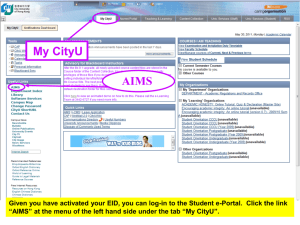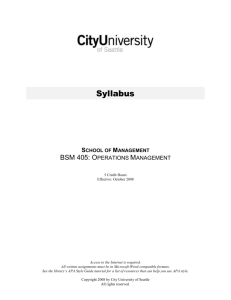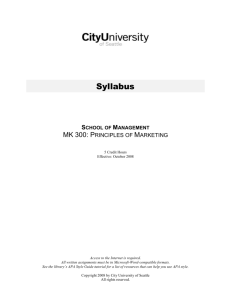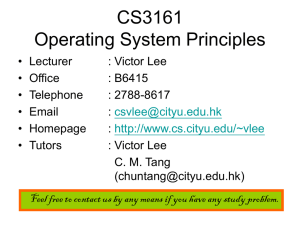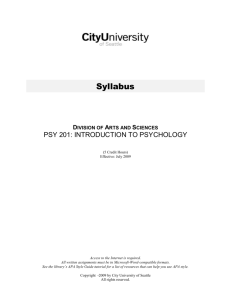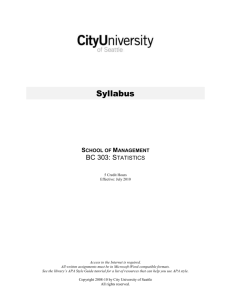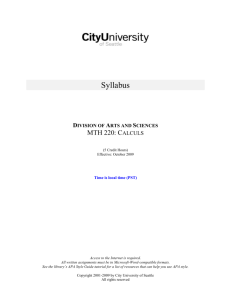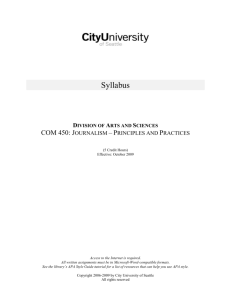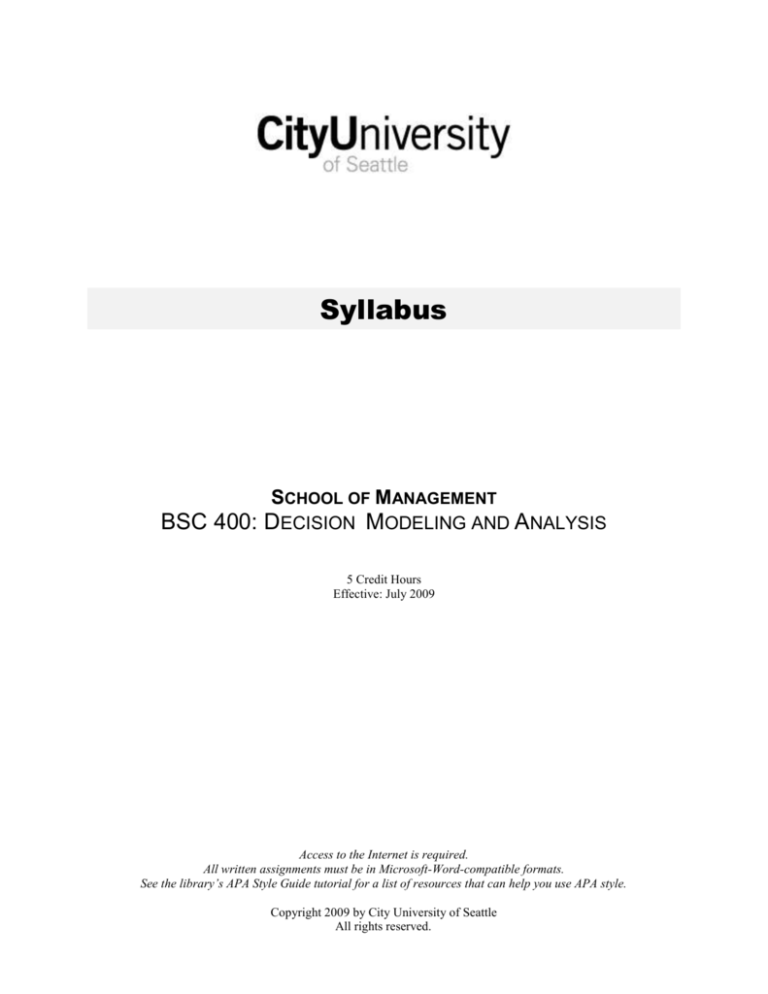
Syllabus
SCHOOL OF MANAGEMENT
BSC 400: DECISION MODELING AND ANALYSIS
5 Credit Hours
Effective: July 2009
Access to the Internet is required.
All written assignments must be in Microsoft-Word-compatible formats.
See the library’s APA Style Guide tutorial for a list of resources that can help you use APA style.
Copyright 2009 by City University of Seattle
All rights reserved.
BSC 400: DECISION MODELING AND ANALYSIS
FACULTY
Faculty Name:
Contact Information:
COURSE DESCRIPTION
BSC400, Decision Modeling and Analysis is an examination of the analytical tools used to make optimal
business decisions. Topics include: decision analysis, linear programming, waiting line models and
project scheduling. There is strong emphasis on understanding business problems and how model
building will assist the decision maker in making better decisions. Students will practice building, using
and modifying business analysis models. It is strongly recommended that College Math be taken prior to
this course.
COURSE RESOURCES
Required and recommended resources to complete coursework and assignments are listed on the
My.CityU portal at Library>Resources by Course.
CITYU LEARNING GOALS
The content of this course addresses the following CityU Learning Goals:
Professional Competency and Identity;
Critical Thinking.
PROGRAM CONTEXT
The content of this course aligns with the following program outcomes:
Evaluate the industry and economic sector in which a given organization operates and propose
strategies to succeed;
Appraise the threats and opportunities of conducting business in a world with fewer barriers;
Integrate information technology tools to streamline business processes;
Recommend improvements that align with the company’s strategies, goals and culture;
Integrate foundational knowledge of business functions;
Assess and evaluate relevant information to guide business decisions.
BSC400
Page 2
Eff: 07/09
COURSE OUTCOMES
In this course, learners will:
Formulate quantitative business models for real business problems;
Apply several quantitative models to a variety of business problems requiring decision analysis;
Apply several quantitative models to business problems requiring forecasting business data;
Develop and apply linear programming models to a variety of business problems using the
graphical solution technique;
Develop and apply linear programming models to a variety of complex business problems using a
computer program;
Use sensitivity analysis to modify the models to better fit the changing business environment;
Build a transportation and assignment network diagram and create the linear programming model
that will provide the optimal solution;
Build a project schedule that can be used to determine the project duration, the critical path and
the probability of completing the project in a certain amount of time;
Analyze a variety of waiting line systems and develop their performance characteristics.
CORE CONCEPTS, KNOWLEDGE, AND SKILLS
Decision Making Steps;
Profit, revenue and cost models;
Breakeven analysis;
Payoff tables and decision trees;
Decision making with and without probabilities;
Expected Value of Perfect Information;
Risk and sensitivity analysis of decision making;
Components of a time series;
Moving Average Model and other smoothing methods of forecasting;
Regression analysis as a causal forecasting model;
Linear programming and graphical solution technique and computer software;
Linear programming sensitivity analysis;
Transportation network and linear programming model;
Assignment network and linear programming model;
Transshipment network and linear programming model;
Project Scheduling with known activity times;
Project scheduling with unknown activity times;
Project scheduling requiring crashing activity times;
Waiting line systems.
BSC400
Page 3
Eff: 07/09
OVERVIEW OF COURSE GRADING
The grade you receive for the course will be derived using City University of Seattle’s decimal grading
system, based on the following:
Overview of Required Assignments
Assigned Problems
Participation/Discussions
Case Analysis
Quizzes or Exams
% of Final Grade
20%
10%
30%
40%
TOTAL
100%
SPECIFICS OF COURSE ASSIGNMENTS
Assigned Problems: You will be assigned problems from the text to practice and reinforce the
various concepts and tools discussed in the chapters for each session. The length and content of the
assigned problems will be up to the individual instructor.
Participation/Discussions
Whether in class, online, or in a mixed mode setting, students will be graded on their participation in
classroom discussions; their ability to present, explain, or defend alternative viewpoints; and the
degree to which they have mastered the concepts and principles inherent in the study of decision
analysis. Written work will be assessed not only on relevance to the subject presented, but also on
adherence to good written form and professional presentation.
Case Analyses – The instructor should assign 2-3 cases that provide you with the opportunity to apply
the methodologies being learned in the course to real business problems. This assignment could
entail a team component on one of the cases. Some examples of the criteria that an instructor could
use when selecting a case are listed below:
Case Type #1: This case would provide a good introduction into how a model can be built that
would help to solve a business problem. A case that is simple in structure might be best. For
example, a case involving the use of Decision Theory or Forecasting might be appropriate
Case Type #2: This case would provide you with a business problem that would require the
students to actually build the original Linear Programming model that would be used to solve it.
The model should then be solved using the Graphical Solution Technique. This provides you
with insight into how the model is affected by the input data and variables.
Case Type #3: This case would provide a good introduction into how a business problem can be
solved using Linear Programming and computer software. You will then be able to use the
software output to interpret the results. Even more importantly, this case should provide insight
into how various small changes to the original model can affect the optimal solution. Its value is
that it shows very quickly that the use of models provides a “base model” that can then be used to
further refine the solution in order to better meet the business needs. The case should stress the
economic interpretation of duality in linear programming.
Case Type #4: This case would provide a simple but very realistic example of how a business
may need to adjust to a changing business situation. The case should contain requirements to
perform several iterations of the original model in order to determine the best adjustment that the
BSC400
Page 4
Eff: 07/09
company should make to the changing needs. Problems involving Project Scheduling,
Transportation Networks or Waiting Line Systems could be used.
Exams/Quizzes: You will take a quizzes and/or exams in the course to reinforce the course materials.
These will test your ability to utilize terminology as well as the identification and application of
proper quantitative methods.
COURSE POLICIES
Late Assignments (Instructors will put their late policy here. Below is an example.)
A 10%, per each day late, penalty will be assessed for all late work. Assignments more than 7 days late
will not be accepted and receive a grade of zero.
Participation
Students are expected to be actively engaged in a discussion or other activities. Active engagement
means contributing substantive, thoughtful and reflective responses. For online classes, students must
submit at least one quality posting, response to another’s posting, or other assigned work on four separate
days during the school week (Monday through Sunday). Additionally, students must post their initial
responses during the first three days of the week, and their responses to other students’ postings during
the last four days of the week.
Professional Writing
All assignments for this course should be of professional quality. The writing should always take into
consideration the intended audience. Hand written work will not be accepted.
This course requires you to use the American Psychological Association (APA) style in preparing any
required research papers, or any written work where other sources are used. References should be cited
for all facts, ideas, conclusions, and opinions that are not your own.
A proper title page should preface all written assignments, unless otherwise stated. The title page should
include: your name, the title of the paper, the name and number of the course, your course start date, the
date submitted, and the name of the instructor.
Your work should be typed or word-processed on white 8 ½ by 11 inch paper. Any narrative sections
should be double-spaced. Some assignments many require that your work be prepared on a computer
spreadsheet.
UNIVERSITY POLICIES
You are responsible for understanding and adhering to all of City University of Seattle’s academic
policies. The most current versions of these policies can be found in the university catalog that is linked
from the CityU Web site.
Academic Integrity
Scholastic honesty in students requires the pursuit of scholarly activity that is free from fraud, deception
and unauthorized collaboration with other individuals. You are responsible for understanding CityU’s
BSC400
Page 5
Eff: 07/09
policy on scholastic honesty and adhering to its standards in meeting all course requirements. A complete
copy of this policy can be found in the university catalog in the section titled Scholastic Honesty under
Student Rights & Responsibilities.
Attendance
Students taking courses in any format at the University are expected to be diligent in their studies and to
attend class regularly. Regular class attendance is important in achieving learning outcomes in the course
and may be a valid consideration in determining the final grade. For classes where a physical presence is
required, a student has attended if s/he is present at any time during the class session. For online classes,
a student has attended if s/he has posted or submitted an assignment during the session. A complete copy
of this policy can be found in the university catalog in the section titled Attendance Policy.
SUPPORT SERVICES
Disability Resources
If you are a student with a disability and you require an accommodation, please contact the Disability
Resource Office as soon as possible. For additional information, please see the section in the university
catalog titled Students with Special Needs under Student Rights & Responsibilities.
Library Services
In order to help you succeed in this course, you have access to library services and resources 24 hours a
day, seven days a week. CityU librarians can help you formulate search strategies and locate materials
that are relevant to your coursework. For help, contact a CityU librarian through the Ask a Librarian
service. To find library resources, click on the Library link in the My.CityU portal.
SmartThinking
As a CityU student, you have access to 10 free hours of online tutoring, including writing support, from
certified tutors 24 hours a day, seven days a week. Contact CityU’s Student Support Center at
info@cityu.edu to request your user name and password.
BSC400
Page 6
Eff: 07/09

